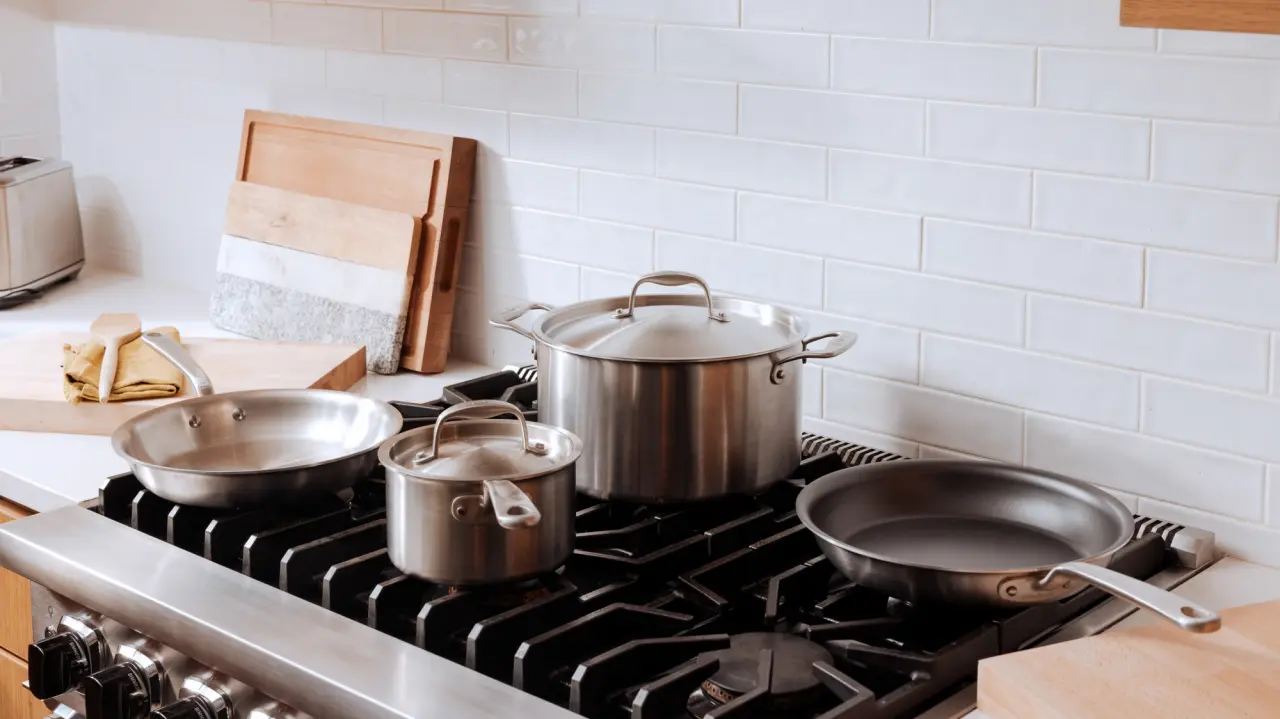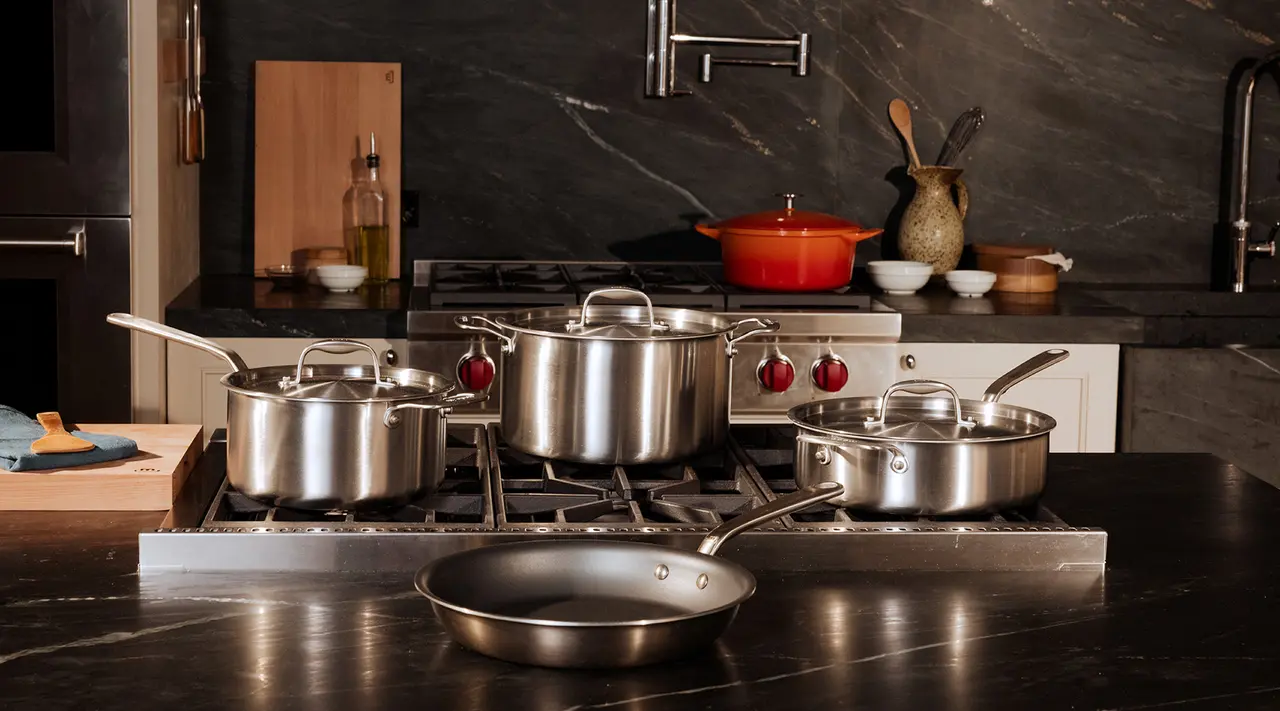A cookware set offers a few advantages over buying pieces a la carte: one, because they typically consist of a curated selection of pieces in different sizes, shapes, and materials, they can streamline the shopping process by removing the guesswork involved with building your collection. Two, they often come at a generous discount, so you can save money per piece.
Of course, not all cookware sets are created equally. Here’s how to make sure you’re buying the best set for your needs—and not just the most aesthetically pleasing one.
What Types of Cookware Sets are Available?

The sky's the limit when it comes to cookware sets. You can go all-in on a full set of stainless steel cookware, or go for a mixture of non stick and stainless steel to hit all your bases. You’ll find sets that include every size and shape of pot and pan you can think of, from staples like saucepans and frying pans to more specialized shapes like sauciers and rondeaus.
For those relatively new to cooking (or indecisive folks) a mixed set is a great, safe bet, and offers an introduction to a range of different shapes and materials. If you head to the Sets section of our website, you’ll find over a dozen different sets to choose from, from a 2-piece Carbon Steel Grilling Set to a 13-piece set of Stainless Clad, Non Stick, and Carbon Steel pots and pans.
Features to Look for in the Best Cookware Set

While you can find some truly great, well-curated cookware sets, not all of them are worth it. Here’s how to make sure you’re reaping all the advantages of a cookware set before you spend a dime.
Ergonomic Handles/Comfortable Grip
Cookware shouldn’t just look great and perform well: it should also feel great to hold. This goes for any pot or pan, but particularly ones you’ll use for frequent flipping or tossing, like a wok or frying pan.
If you can, check out the sets you have your eye on in person before buying. This can be helpful for a lot of reasons, but a big one is the ability to test out each piece to make sure the handles feel comfortable—not heavy or unwieldy—to hold and pick up. It’s important to figure this out early and not when your hand cramps mid-way through a bolognese.
Oven and Dishwasher Safety
If dishwasher safety is a top priority for you, make sure your set is dishwasher compatible before purchasing. Many materials, such as non stick, ceramic, and enameled cast iron, can easily be damaged or ruined by running them through the dishwasher—this is why we recommend hand-washing all cookware items if possible (even if they’re labeled dishwasher-friendly!) in order to keep them in peak condition. That said, if you’re looking for ease and convenience above all else, do your due diligence before sticking your brand-new pan in the dishwasher.
While you’re at it, it’s also helpful to check whether all the pieces in a set are oven-safe. Whereas materials like stainless steel, carbon steel, and cast iron are great for oven use, non stick and ceramic shouldn’t be used for extended periods of time in the oven, or at too high of a temperature (our non stick is oven-safe up to 500F). Doing so can degrade the non stick coating and permanently damage your pan.
Pans made of any material with plastic handles should also be kept out of the oven at any time—these are typically only for stovetop use, as high heat melts lower-quality plastic.
Stackability and Storage Efficiency
Nothing ruins the thrill of getting your new brand-new cookware set more than realizing you don’t actually have the space for it. One of the advantages of buying a set of pots and pans is that they’re often designed for convenient nesting and stacking—still, it’s a good idea to check whether or not you can comfortably fit it all in your kitchen. The key thing to remember when stacking pans is to always, always, always include a Pan Protector, trivet, or dish towel between the cooking surface of one pan and the bottom of another—especially if you're stacking a non stick pan.
Luckily, our guide to proper pan storage should come in handy for more information here.
Warranty and Customer Support
Even if you’re buying high-quality pieces from a reputable brand, a solid warranty—ideally lifetime—should offer a little peace of mind. Warranties are meant to cover manufacturing defects, so if your cookware arrives damaged or doesn’t perform the way it’s supposed to, you’ll usually be able to return it for a full refund.
Many of our sets (including our Stainless Set and Enameled Cast Iron Set) come with a lifetime warranty, and the rest come with a 1-year limited warranty. We also have an in-house team of customer service representatives available to answer any cookware-related question you might have, from whether damage is covered in the warranty to what recipes to make.
Factors to Consider When Choosing a Cookware Set
Cookware sets should fit your kitchen and lifestyle—not the other way around. Make sure you keep factors like budget, cooking style, and cooktop compatibility in mind.
Budget Considerations
As a rule, cookware sets require a slightly larger upfront cost than buying individual pieces—though that doesn’t mean you need to take out a second mortgage just to outfit your kitchen. Just make sure you’re buying from a reputable brand that you enjoy using, and be wary of deals that seem too good to be true (spoiler: they often are).
Paying more upfront for cookware often guarantees that each piece is constructed from durable, high-quality materials that will last you for years (or even decades). While some sets may be cheaper, they will typically need to be replaced sooner—all but offsetting the initial savings.
Compatibility with Different Cooking Surfaces
It probably goes without saying, but you’ll want to make sure that all the pieces in a new cookware set are compatible with your cooktop before taking the plunge. While carbon steel, stainless steel, and cast iron are compatible with nearly every cooking surface, including induction, certain materials—such as unfinished cast iron—can scratch the surface of glass cooktops. Cookware made from porcelain, copper, or glass are not typically induction compatible.
For non stick sets, it’s worth noting that both traditional coated and ceramic non stick cookware are not ideal for oven or grill use—nor for extended high heat cooking. While our CeramiClad™ and ProCoat Non Stick lines are technically safe to use in the oven up to 500F, we don’t recommend using it for long periods of time, as this could degrade the coating.
Cooking Needs
When shopping for a new cookware set, it pays to be honest with yourself: will you really use all—or even most—of the pieces included? Try to look for sets that consist mostly of cookware styles you’ve used before, and limit the number of novel or unfamiliar pieces.
To help, think about how you cook on a regular basis: do your meals consist mainly of simple stir-fries, pastas, and eggs? Go for a non stick frying pan set, or a mix of non stick and stainless. Are you really going to use a carbon steel wok or stainless steel rondeau? If not, they’ll just add extra clutter to your cabinet.
Durability and Longevity
Any cookware you buy should last for a few years at the very least, and ideally for decades or longer. Some materials—like non stick—aren’t built to last as long as cast iron or stainless steel, but that doesn’t mean they should break down after just a few months.
If you can, invest a little more in a sturdy, long-lasting set: carbon steel, stainless steel, and enameled cast iron pots and pans are some of the most durable pieces you can buy, and can even stick around long enough to become heirlooms.
Heat Conductivity and Distribution
We’ve already touched on the importance of buying a durable, well-made set of cookware, and a major facet of that is a pot or pan’s ability to conduct and distribute heat. This is crucial when it comes to cookware, as pans with poor heat distribution often wind up with hot or cold spots, leading to uneven cooking.
These pans are often also slow to respond to changes in temperature, making them harder to regulate. Materials like stainless steel, carbon steel, and copper are excellent at conducting and distributing heat; cast iron, less so.
For stainless steel, look for pieces made with at least 3 ply, or layers, of different metals—ideally 5 (read up on the differences between 3-ply and 5-ply stainless clad in our guide). If you’re looking to buy a non stick set, we highly recommend pieces made with a stainless clad base for optimal conductivity and temperature control.
Maintenance and Cleaning Requirements
Cookware that’s a pain in the neck to clean and take care of is, well, a pain in the neck. Just like you should be honest with yourself about your budget, storage capacity, and cooking style, you should also be realistic about how much maintenance you’re willing to do.
For instance: don’t mind seasoning (and reseasoning) your pan? Carbon steel or unfinished cast iron are both solid choices. Prefer something more beginner-friendly or low-maintenance? Go for non stick or stainless steel.
Ready to Shop?
Cookware sets are wonderful for so many reasons: not only are they an economical option, but they can also reduce the decision fatigue that can come from outfitting your home kitchen. Like with any major purchase, however, make sure you’re buying from a brand you trust.
Each piece included in our cookware sets are warranty-backed and recommended by some of the most respected chefs in the world so you can feel confident about going all-in on one of our curated cookeware sets.
























